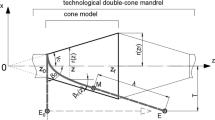Abstract
This paper presents a topological mapping algorithm for ellipsoid component winding trajectory. The sphere with double opposite holes was used as initial winding trajectory design model. The double opposite holes ellipsoid winding trajectory was obtained form that of the double-holes-sphere based on topological mapping algorithm. The basic equation of equilibrium for ellipsoidal mapping trajectory was given and its slippage coefficients were calculated using the non-geodesic law and differential geometry. The variation of slippage coefficients with holes-radius and ellipsoid rate were analyzed. The results show that, when ellipsoidal rate get close to 1 gradually, the better stability of fiber trajectories was obtained by topological mapping function. The ellipsoid component with lager holes-radius requires lower coefficient of friction between the fiber bundle and the ellipsoid surface. This fiber trajectory mapping function in the paper presents a useful tool for designing the double opposite holes ellipsoid filament-wound component trajectory.











Similar content being viewed by others
References
Scholliers J., Van Brussel H.: Computer-integrated filament winding: computer-integrated design, robotic filament winding and robotic quality control. Compos. Manuf. 5(1), 15–23 (1994)
Lossie M., Van Brussel H.: Design principles in filament winding. Compos. Manuf. 5(1), 5–13 (1994)
Banerjee A., Sun L., Mantell S.C., Cohen D.: Model and experimental study of fiber motion in wet filament winding. Compos. A: Appl. Sci. Manuf. 29(3), 251–263 (1998)
Weaver A.: Designing for winding. Reinforced Plastics (UK). 40(10), 28–30 (1996)33–34
Laval C.: CADWIND 2006–20 years of filament winding experience. Reinf. Plast. 50(2), 34–37 (2006)
Middleton, V., Young, K.W., Elliman, D.G., Owen, M.J.: Software for filament winding. Automated Composites; Nottingham; UK; 10–12 Sept. 1986: pp. 9.1–9.6 (1986)
Priestley A.: Filament winding of complex components. Reinf. Plast. 36(7–8), 42–44 (1992)
Zu L., Koussios S., Beukers A.: Design of filament-wound isotensoid pressure vessels with unsual polar openings. Compos. Struct. 92(9), 2307–2313 (2010)
Smith D.M.: Engineering Computation with MATLAB. Addison Wesley, New Jersey (2007)
Shiohama K., Shioya T., Tanaka M.: The geometry of total curvature on complete open surfaces, pp. 137–140. Cambridge University Press, Cambridge (2003)
Zomorodian A.J.: Topology for computing, pp. 261. Cambridge University Press, Cambridge (2005)
Conder M., Potočnik P., Širáň J.: Regular maps with almost Sylow-cyclic automorphism groups, and classification of regular maps with Euler characteristic. Journal of Algebra. 324(10), 2620–2635 (2010)
Conder, M., Nedela, R., Širáň, J.: Classification of regular maps of Euler characteristic. J. Comb. Theory, Ser. B,: pp. 1–15 (2012)
Bruce King R.: Platonic tessellations of Riemann surfaces as models in chemistry: non-zero genus analogues of regular polyhedra. J. Mol. Struct. 656(1–3), 119–133 (2003)
Kocay, W. Kreher, D.: Graphs, algorithms, and optimization. CRC Press [CAM], Boca Raton (2005)
Ivanov, A.A., Liebeck, M.W., Saxl, J.: Groups, combinatorics & geometry : Durham, 2001.: World scientific. 347p (2003)
Spence, J.A.S. Tooth, pressure vessel design : Concepts and principles.: E & FN Spon. 508p (1994)
Aguilar, M.A., Gitler, S., Prieto, C.: Algebraic topology from a homotopical viewpoint, pp. 510. Springer, New York (2002).
De Carvalho J., Lossie M., Vandepitte D., Van Brussel H.: Optimization of filament-wound parts based on non-geodesic winding. Compos. Manuf. 6(2), 79–84 (1995)
Pressley A.: Elementary differential geometry, pp. 217–220. Springer, London (2012)
Gray, A., Abbena, E., Salamon, S.: Modern differential geometry of curves and surfaces with Mathematica. Chapman & Hall CRC, Boca Raton (2006)
Vasiliev V.V., Krikanov A.A., Razin A.F.: New generation of filament-wound composite pressure vessels for commercial applications. Compos. Struct. 62(3–4), 449–459 (2003)
Author information
Authors and Affiliations
Corresponding author
Rights and permissions
About this article
Cite this article
Min, R., Liu, B. Fiber Trajectories Design of Ellipsoid Component Based on Topological Mapping Methodology. Appl Compos Mater 24, 661–674 (2017). https://doi.org/10.1007/s10443-016-9533-0
Received:
Accepted:
Published:
Issue Date:
DOI: https://doi.org/10.1007/s10443-016-9533-0




